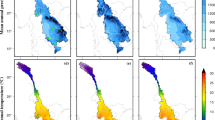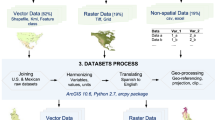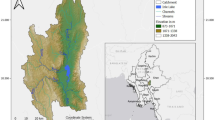Abstract
The increasing availability of spatial data inspires the exploration of previously less-studied, yet regionally and nationally important areas, such as the Irrawaddy and Salween River Basins in Southeast Asia. This article documents our experience using global datasets to create environmental basin profiles in these two basins. Our approach draws on the concepts of freshwater vulnerability assessments that guided the selection of indicators. Data on land use, population distribution and fertilizer load were used. The unit of analysis was chosen to distinguish areas with similar bio-geographical characteristics, such as the critical delta areas. Results were further discussed for sub-areas that experience relatively the most pressure in terms of examined indicators within the studied area. The river mouths of both rivers had the most intensive land use and high population density. They are also home to important ecosystems and are sensitive to changes in upstream areas. Our study presents a concise and spatially distributed view of the environmental basin profiles of the Irrawaddy and Salween River Basins. The analysis also provides some interesting methodological insights about the potential of public macro-scale datasets for environmental assessment. The spatial approach allowed the analysis of different indicators, providing a platform for data integration as well as a visually powerful overview of the study area. Yet, the use of macro-scale datasets entails challenges. Despite improvements, the assessment process tends to be driven by the availability and quality of data, rather than by the actual research and management needs. The greatest utility of macro-scale datasets lies—at least in data-poor areas—in larger scale comparative analyses between the basins and their different sub-areas.





Similar content being viewed by others
References
Abson DJ, Dougill AJ, Stringer LC (2012) Using Principal Component Analysis for information-rich socio-ecological vulnerability mapping in Southern Africa. Appl Geogr 35(1–2):515–524
Allen DJ, Molur S, Daniel BA (2010) The Status and Distribution of Freshwater Biodiversity in the Eastern Himalaya. The IUCN Red List of Threatened Species (TM) Cambridge, UK and Gland, Switzerland: IUCN, and Coimbatore, India: Zoo Outreach Organisation
GWSP Digital Water Atlas (2008a) Map 38: Mean Annual Surface Runoff 1950–2000 (V1.0) GWSP Digital WaterAtlas. http://atlas.gwsp.org/index.php?option=com_content&task=view&id=96&Itemid=68. Accessed 9 Apr 2009
GWSP Digital Water Atlas (2008b) Map 48: Nitrogen Load (Mobilizable) (Dataset) (V1.0) GWSP Digital WaterAtlas. http://atlas.gwsp.org/index.php?option=com_content&task=view&id=154&Itemid=52. Accessed 9 Apr 2009
GWSP Digital Water Atlas (2008c) Map 54: Change in Discharge due to Deforestation (relative) (Dataset) (V1.0) GWSP Digital WaterAtlas. http://atlas.gwsp.org/index.php?option=com_content&task=view&id=160&Itemid=52. Accessed 9 Apr 2009
GWSP Digital Water Atlas (2008d) Map 57: Nitrogen Load (Industrial Fertilizer) (Dataset) (V1.0) GWSP Digital WaterAtlas. http://atlas.gwsp.org/index.php?option=com_content&task=view&id=163&Itemid=52. Accessed 9 Apr 2009
Babel MS, Wahid SM (2009) Freshwater under threat—South East Asia, Vulnerability Assessment of Freshwater Resources to Environmental Change—Mekong River Basin. United Nations Environment Programme (UNEP) & Asian Institute of Technology (AIT), UNEP, Nairobi, Kenya
Bandyopadhyay J, Gyawali D (1994) Himalayan water resources: Ecological and political aspects of management. Mt Res Dev 14(1):1–24
Bates B, Kundzewicz ZW, Wu S, Palutikof J (eds) (2008) Climate change and water, vol VI. Technical Paper of the Intergovernmental Panel on Climate Change IPCC Secretariat, Geneva
BEWG (2011) Burma’s environment: people, problems, policies. The Burma Environmental Working Group (BEWG), Chiang Mai
Bird MI, Robinson RAJ, Win Oo N, Maung Aye M, Lu XX, Higgitt DL, Swe A, Tun T, Lhaing Win S, Sandar Aye K, Mi Mi Win K, Hoey TB (2008) A preliminary estimate of organic carbon transport by the Ayeyarwady (Irrawaddy) and Thanlwin (Salween) Rivers of Myanmar. Quat Int 186(1):113–122
Blasco F, Aizpuru M (2002) Mangroves along the coastal stretch of the Bay of Bengal: present status. Indian J Mar Sci 31(1):9–20
Bot AJ, Nachtergaele FO, Young A (2000) Land resource potential and constraints at regional and country levels. World Soil Resources Report. Land and Water Development Division, Food and Agriculture Organization of the United Nations, Rome
Cash DW, Adger NW, Berkes F, Garden P, Lebel L, Olsson P, Pritchard L, Young O (2006) Scale and cross-scale dynamics: governance and information in a multilevel world. Ecol Soc 11(2):8
Chavoshian A, Ishidaira H, Takeuchi K, Yoshitani J (2007) Hydrological Modeling of Large-scale Ungauged Basin Case Study of Ayeyarwady (Irrawaddy) Basin, Myanmar. Paper presented at the HRSD 2007 Conference in conjunction with the 15th Regional Steering Committee Meeting for UNESCO-IHP Southeast Asia and The Pacific, Manila, Philippines, 22–23 November 2007
Colin C, Turpin L, Bertaux J, Desprairies A, Kissel C (1999) Erosional history of the Himalayan and Burman ranges during the last two glacial-interglacial cycles. Earth and Planetary Science Letters 171(4):647–660
Colin C, Bertaux J, Turpin L, Kissel C (2001) Dynamics of the erosion in the Irrawaddy River basin during the last two climatic cycles (280–0 ka). C R Acad Sci 332(8):7
Crowther S, Vridhachalam M, Tomala-Reyes A, Guerra A, Chu H, Eckman B (2008) Collaboration in river basin management: The Great Rivers Project. Paper presented at the American Geophysical Union, Fall Meeting 2008, 12/2008
del Campo AG (2012) GIS in environmental assessment: a review of current issues and future needs. J Environ Assess Policy Manag 14(1):125007. doi:10.1142/S146433321250007X
DSS (2009) Website of Data Synthesis System for World Water Resources. Overview and citations. http://www.wwap-dss.sr.unh.edu/. Accessed 12 Jan 2012
Dudgeon D (2005) River rehabilitation for conservation of fish biodiversity in moonsonal Asia. Ecol Soc 10(2)
Ericson JP, Vörösmarty CJ, Dingman SL, Ward LG, Meybeck M (2006) Effective sea-level rise and deltas: causes of change and human dimension implications. Global Planet Change 50:63–82
ESA (2008, updated 2009) GlobCover Land Cover (v2.2) dataset, developed as part of the GlobCover project, a European Space Agency (ESA) initiative in partnership with JRC, EEA, FAO, UNEP, GOFC-GOLD, and IGBP GEO Data Portal. http://geodata.grid.unep.ch/. Accessed 9 Apr 2009
FAO (2001) Global Ecological Zones, spatial database of global ecological zones Food and Agriculture Organization of the United Nations (FAO). http://www.fao.org/geonetwork. Accessed 9 Apr 2009
Feng Y, He D, Li Y (2010) Ecological changes and the drivers in the Nu River basin (upper Salween). Water Int 35(6):786–799
Fitterer JL, Nelson TA, Coops NC, Wulder MA (2012) Modelling the ecosystem indicators of British Columbia using Earth observation data and terrain indices. Ecol Indic 20:151–162. doi:10.1016/j.ecolind.2012.02.024
Furuichi T, Win Z, Wasson RJ (2009) Discharge and suspended sediment transport in the Ayeyarwady River, Myanmar: centennial and decadal changes. Hydrol Process 23(11):1631–1641
Gibson CC, Ostrom E, Ahn TK (2000) The concept of scale and the human dimensions of global change: a survey. Ecol Econ 32(2):217–239
Grübler A, O’Neill B, Riahi K, Chirkov V, Goujon A, Kolp P, Prommer I, Scherbov S, Slentoe E (2007) Regional, national, and spatially explicit scenarios of demographic and economic change based on SRES. Technol Forecast Soc Change 74(7):980–1029
GWP (2000) Integrated Water Resources Management, TAC Background Papers No. 4. Technical Advisory Committee (TAC), Global Water Partnerhship (GWP), Stockholm, Sweden
GWSP (2011) Website of the Global Water System Project (GWSP). The Global Water System Project. http://www.gwsp.org/. Accessed 6 Sept 2011
Hedley PJ, Bird MI, Robinson RAJ (2010) Evolution of the Irrawaddy delta region since 1850. Geogr J 176(2):138–149
Hope R, Hansen K, Mutembwa M, Schlessinger S (2012) Water Security, Risk and Society—Key Issues and Research Priorities for International Development. Synthesis report submitted to UK Collaborative on Development Sciences by Oxford University Water Security Network, Available at: www.water.ox.ac.uk and www.ukcds.org.uk
Huang Y, Cai M (2009) Methodologies guidelines—vulnerability assessment of freshwater Resources to environmental change. United Nations Environment Programme (UNEP) & Peking University, China in collaboration with Mongolian Water Authority and Asian Institute of Technology (AIT), Khlong Nueng
IPCC (2001) Intergovernmental panel on climate change: climate change 2001: impacts, adaptation and vulnerability. Cambridge University Press, Cambridge
IUCN and UNEP (2009) The World Database on Protected Areas (WDPA) UNEP-WCMC. www.wdpa.org. Accessed 9 Apr 2009
Jolliffe IT (2002) Principal Component Analysis. Springer-Verlag NY Inc., New York
Jonhson DP, Stanforth A, Lulla V, Luber G (2012) Developing an applied extreme heat vulnerability index utilizing socioeconomic and environmental data. Appl Geogr 35(1–2):23–31
Kattelus M (2009) Planning and management of water resources in Myanmar: role of agriculture and hydropower. Master’s Thesis, Helsinki University of Technology, Espoo
Keskinen M (2008) Population, natural resources & development in the Mekong: does high population density hinder development? In: Kummu M, Keskinen M, Varis O (eds) Modern myths of the Mekong. Water & Development Publications—Helsinki University of Technology, Espoo
Keskinen M (2010) Bringing back the common sense? Integrated approaches in water management: lessons learnt from the Mekong. Doctoral Thesis, Water & Development Publications, Aalto University
Kravtsova VI, Mikhailov VN, Kidyaeva VM (2009) Hydrological regime, morphological features and natural territorial complexes of the Irrawaddy River Delta (Myanmar). Water Resour 36(3):243–260
Kummu M, Varis O (2007) Sediment-related impacts due to upstream reservoir trapping, the Lower Mekong River. Geomorphology 84(3–4):275–293
Kummu M, Lu XX, Wang JJ, Varis O (2010) Basin-wide sediment trapping efficiency of emerging reservoirs along the Mekong. Geomorphology 119(3–4):181–197
LANDSCAN (2008) Landscan (TM) Global Population Database Oak Ridge National Laboratory. http://www.ornl.gov/landscan/. Accessed 9 Apr 2009
Lebel L (2009) The global environmental change and development. In: Lebel L, Snidvongs A, Chen C-TA, Daniel R (eds) Critical states. Unit for Social and Environmental Research (USER), Chiang Mai, p 473
Lebel L, Garden P, Imamura M (2005) The politics of scale, position, and place in the governance of water resources in the Mekong region. Ecol Soc 10(2):18
Lehner B, Döll P (2004) Development and validation of a global database of lakes, reservoirs and wetlands. J Hydrol 296(1–4):1–22
Leimgruber P, Kelly DS, Steininger MK, Brunner J, Müller T, Songer M (2005) Forest cover change patterns in Myanmar (Burma) 1990–2000. Environ Conserv 32(04):356–364. doi:10.1017/S0376892905002493
Li AN, Wang AS, Liang SL (2006) Eco-environmental vulnerability evaluation in the mountainous region using remote sensing and GIS—a case study in the upper reaches of Mingjiang River, China. Ecol Model 192:175–187
Linard C, Tatem AJ (2012) Large-scale spatial population databases in infectious disease research. Int J Health Geogr 11:13
Lu XX, Zhang SR, Xu JC, Merz J (2009) The changing sediment loads of the Hindu Kush-Himalayan rivers: an overview. In: IAHS-AISH Publication, Hyderabad, 2009. Workshop on Sediment Problems and Sediment Management in Asian River Basins. pp 21–36
Magee D, Kelley S (2009) Damming the Salween River. In: Molle F, Foran T, Käkönen M (eds) Contested waterscapes in the Mekong region—Hydropower, Livelihoods and Governance. Earthscan, London, pp 115–140
McNally A, Magee D, Wolf AT (2009) Hydropower and sustainability: resilience and vulnerability in China’s powersheds. J Environ Manag 90(SUPPL. 3):S286–S293
Moench M, Dixit A (eds) (2007) Working with the winds of change—towards strategies for responding to the risks associated with the climate change and other hazards. 2nd edn. ProVention Consortium; Institute for Social and Environmental Transition-International, Institute for Social and Environmental Transition-Nepal, Kathmandu, Nepal
Molle F, Mollinga P (2003) Water poverty indicators: conceptual problems and policy issues. Water Policy 5:529–544
Myint Aung U (2007) Policy and practice in Myanmar’s protected area system. J Environ Manag 84(2):188–203
Perveen S, James LA (2011) Scale invariance of water stress and scarcity indicators: facilitating cross-scale comparisons of water resources vulnerability. Appl Geogr 31(1):321–328
Rahaman MM, Varis O (2005) Integrated water resources management: evolution, prospects and future challenges. Sustainability: Science, Practice, & Policy (SSPP) 1(1):15–21
Revenga C, Murray S, Abramovitz J, Hammond A (1998) Watersheds of the world: ecological value and vulnerability. A joint publication by the World Resource Institute and the Worldwatch Institute, Washington, DC
Rieffel L (ed) (2010) Myanmar/Burma—inside challenges, outside interests. The Brooking Institution, Washington, DC
RivDis (1998) The Global River Discharge Database (RivDis v.1.1) by Vörösmarty, C.J., Fekete, B., and Tucker, B.A. Institute for the Study of Earth, Oceans, and Space; University of New Hampshire. http://www.rivdis.sr.unh.edu/. Accessed 6 Sept 2011
Robinson RAJ, Bird MI, Nay WIN, Oo HoeyTB, Aye MaungMaung, Higgitt DL, Lu XX, Swe Aung, Tun Tin, Win SweLhaning (2007) The Irrawaddy River sediment flux to the Indian Ocean: the original nineteenth-century data revisited. J Geol 115:629–640
Rotmans J, van Asselt M (1996) Integrated assessment: a growing child on its way to maturity. Clim Change 34(3):327–336
Salmivaara A (2009) Current vulnerability and future challenges of water resources in the Irrawaddy and Salween River Basins—indicator-based geospatial analysis. Master’s Thesis, Helsinki University of Technology, Espoo
Salmivaara A (2012) Chapter 10 Myanmar: Assessing Freshwater Vulnerability in the Irrawaddy and Salween River Basins. In: Lamadrid A, Kelman I (eds) Climate Change Modeling For Local Adaptation In The Hindu Kush-Himalayan Region, vol 11. Community, Environment and Disaster Risk Management. Emerald Group Publishing Limited. doi:http://dx.doi.org/10.1108/S2040-7262(2012)0000011016
Sharma E, Xu J (2007) Land-use, landscape management and environmental services in the mountain mainland Asia: introduction. Trop Ecol 48(2):129–136
Sullivan CA, Vörösmarty CJ, Craswell E, Bunn S, Cline S, Heidecke C, Storeygard A, Proussevitch A, Douglas E, Bossio D, Günther D, Giacomello AM, O’Regan D, Meigh J (2006) Mapping the links between water, poverty and food security. In: Water indicators workshop held at the Centre for Ecology and Hydrology, Wallingford, UK, 16–19 May 2005. GWSP Issues in GWS Research, No. 1. GWSP IPO, Bonn, p 60
Than M (2006) Changing faces of the Ayeyarwady (Irrawaddy) Delta (1850–2000). Paper presented at Chao Phraya Delta: historical development, Dynamics, and challenges of Thailand’s Rice Bowl, 12–15 December 2000, Kasetsart University, Bangkok
UNEP (2006a) Nighttime Lights 1994-1995, The GEO Data Portal, as compiled from the NOAA/NGDC, Defense Meteorological Satellite Program (DMSP) United Nations Environment Programme UNEP/DEWA/GRID-Europe, GEO Data Portal. http://geodata.grid.unep.ch. Accessed 9 Apr 2009
UNEP (2006b) Potential Rainfed Food Production, compiled from FAO, TERRASTAT I Global GIS Databases Poverty and Food Insecurity Mapping Project United Nations Environment Programme UNEP/DEWA/GRID-Europe, GEO Data Portal. http://geodata.grid.unep.ch). Accessed 9 Apr 2009
USDA (1993) Definitions of slope classes (Table 3-1). Soil Survey Division Staff. Soil survey manual. Handbook 18. Soil Conservation Service U. S. Department of Agriculture (USDA), Washington, DC
USGS (1996) GTOPO30 Global digital elevation model (DEM) U.S. Geological Survey (USGS). http://edc.usgs.gov/products/elevation/gtopo30/gtopo30.html). Accessed 9 Apr 2009
USGS (2001) Drainage basins of the world, part of the Global GIS Database by U. S. Geological Survey (USGS) U. S. Geological Survey (USGS). http://webgis.wr.usgs.gov/globalgis/). Accessed 9 Apr 2009
Varis O, Kummu M, Salmivaara A (2012) Ten major river basins in monsoon Asia-Pacific: an assessment of vulnerability. Appl Geogr 32(2):441–454
Vörösmarty CJ (2002) Global water assessment and potential contributions from earth systems science. Aquat Sci 64:24
Vörösmarty CJ, Green P, Salisbury J, Lammers RB (2000) Global water resources: vulnerability from climate change and population growth. Science 289(5477):284–288
Vörösmarty CJ, McIntyre PB, Gessner MO, Dudgeon D, Prusevich A, Green P, Glidden S, Bunn SE, Sullivan CA, Liermann CR, Davies PM (2010) Global threats to human water security and river biodiversity. Nature 467:555–561
Walling DE (2006) Human impact on land-ocean sediment transfer by the world’s rivers. Geomorphology 79(3–4):192–216
Walling DE (2009) Human impact on the sediment loads of Asian rivers. In: IAHS-AISH Publication, Hyderabad, 2009. Workshop on Sediment Problems and Sediment Management in Asian River Basins, Hyderabad, pp 37–51
Wang SY, Liu JS, Yang CJ (2008) Eco-environmental vulnerability evaluation in the Yellow River Basin, China. Pedosphere 18(2):171–182
Wang ZY, Yu GA, Huang HQ, Wang RY (2012) Gender of large river deltas and parasitizing rivers. Int J Sediment Res 27(1):18–36
Water Resources eAtlas (2007) Water Resources eAtlas, Watersheds of the World—A Special Collection of River Basin Data World Resource Institute. http://earthtrends.wri.org/maps_spatial/watersheds/about.php. Accessed 9 Apr 2009
Yamamoto K, Fukuda Y, Nakaegawa T, Nishijima J (2007) Landwater variation in four major river basins of the Indochina peninsula as revealed by GRACE. Earth Planets Space 59(4):193–200
Yusuf AA, Francisco H (2009) Climate Change Vulnerability Mapping for Southeast Asia. Economy and Environment Program for Southeast Asia (EEPSEA) publications, Singapore
Zakaria-Ismail M (1994) Zoogeography and biodiversity of the freshwater fishes of Southeast Asia. Hydrobiologia 285(1–3):41–48
Acknowledgments
The authors would like to thank the anonymous reviewers for their constructive suggestions and comments which lead to major improvements in the manuscript. The authors also express gratitude to all the members of Aalto University’s Water & Development Research Group for their support. Aura Salmivaara received funding from the TKK Researcher Scholarship and VALUE Doctoral School. Matti Kummu received funding from the postdoctoral funds of Aalto University. Marko Keskinen received funding from the Academy of Finland project 133748. The work was partially funded also by Maa- ja vesitekniikan tuki ry.
Author information
Authors and Affiliations
Corresponding author
Electronic supplementary material
Below is the link to the electronic supplementary material.
Rights and permissions
About this article
Cite this article
Salmivaara, A., Kummu, M., Keskinen, M. et al. Using Global Datasets to Create Environmental Profiles for Data-Poor Regions: A Case from the Irrawaddy and Salween River Basins. Environmental Management 51, 897–911 (2013). https://doi.org/10.1007/s00267-013-0016-x
Received:
Accepted:
Published:
Issue Date:
DOI: https://doi.org/10.1007/s00267-013-0016-x




